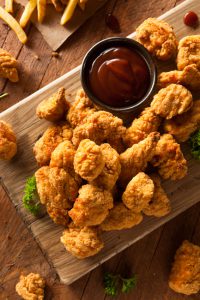 Your bar could earn some serious profits from serving hot food, but you may think it also requires a serious investment in a kitchen. Think again, as ventless and hoodless equipment allows bars to serve everything from chicken tenders, french fries, pizzas, mozzarella sticks, and other appetizers without the need for a full kitchen.
Your bar could earn some serious profits from serving hot food, but you may think it also requires a serious investment in a kitchen. Think again, as ventless and hoodless equipment allows bars to serve everything from chicken tenders, french fries, pizzas, mozzarella sticks, and other appetizers without the need for a full kitchen.
“Unless a space is already outfitted with a hood system, hoods and venting can be really expensive to install and maintain,” says Bess Wightman, Marketing Manager of MTI Products, AutoFry/MultiChef. “Depending on the layout of a building and how far the vented air needs to travel to get out of the building, you’re looking at anywhere from $10,000-30,000 just in installation costs.”
Ventless and hoodless units that cook food via oil or hot air bypass the need for those installations and can be installed anywhere. “It enables any operators to serve a full hot food menu in spaces that were never intended or designed for food service,” says James Pool, President of TurboChef.
The equipment also allows bars with existing kitchens to expand their menus and cooking capabilities, especially if there is no additional room beneath their existing hood.
“Even if it’s a bar with a full kitchen in the back, a lot of times they’ll close the kitchen at 10, but the bar might stay open until three, four in the morning,” says Dylan Yussman, Director of Emerging Chains for the Middleby Corporation, Perfect Fry. “In that case, you can go ahead and send your chefs and everyone in the back of the house home and keep that Perfect Fry going.”
The units are safe and easy to operate—most are plug-and-play and can be operated by any staff member. “The fryer has to be enclosed and contained to operate without vents,” says Wightman. “Which means employees never come in contact with hot oil. This can help reduce kitchen accidents, as the number one common kitchen hazard is burns.”
Of course, the units aren’t without an upfront cost, but the ROI is reasonable. “Yes, it is an expensive machine from the get-go, but when you’re dealing with a bar that’s starting a fried food program for the first time, the return on investment is pretty unbelievable,” says Yussman. “The cost of french fries and chicken fingers and fried food alone is pretty cheap.”
Paul Artt, President and Founder of Quik N Crispy, says he tells customers a 6-12 month ROI is realistic and doable, but it all depends on what a bar charges for the food. “Business owners are hesitant to charge higher prices,” he says. “If you have a captive audience and a reason why people are frequenting your establishment, and they want to get something to eat, they’re not going to be hesitant to spend $7.95 for a precooked burger and fries.
“We tell our customers that French fries should have around an 80% growth profit margin, and your mainstream appetizers (chicken wings, boneless chicken wings, cheese sticks, jalapeño poppers, etc.) should be more in the 60-70% gross profit range.”
Artt also advises bar owners to manage their food inventory the same way they would their liquor or beer. He stresses that inventory control and portion control is key.
To reach that ROI, it’s also important to keep the machines in tip-top operating shape by performing routine cleaning and maintenance. Most manufacturers recommend daily, weekly, and monthly cleanings and offer guidelines for how to do each. Daily maintenance includes spot cleaning and filtering the oil for units that fry with oil. Weekly and monthly maintenance is more extensive and can require soaking parts of the units and changing out oil on applicable machines.
So how does a bar choose the best unit? The first thing to consider is the size of your bar and the volume of food you intend to cook. Artt says to ask yourself, “What is a busy period for you, and how many people will you be serving?”
Manufacturers also provide units in different voltage options to accommodate a bar’s specific electrical needs. Higher amp units cook and recover heat faster.
Here’s just a sample of the ventless units available to bars and restaurants:
AutoFry: The company’s smallest unit can handle up to two pounds of product at a time, while it’s largest unit can cook eight pounds of product at once. Double basket units are available for higher volume locations, and each side operates independently, which can save on oil costs. The MTI-10X is the most popular unit, and it cooks up to four pounds at a time and holds 2.75 gallons of oil. Its compact design takes up less counter space. MTI’s proprietary Simplifry™ technology offers multiple programmable presets, standby mode, and heat/time compensation intelligence.
MultiChef: Using a unique combination of convection, direct infrared, and Rotary Air Impingement, MultiChef allows you to cook, steam, roast, toast, melt, bake, and reheat items. The MultiChef 5500 unit has a 12-inch cavity and 650 square inches of cooking capacity. The MultiChef 6500 has a 16-inch cavity and 992 square inches of cooking capacity. The 6500 model can cook two thick crust 16-inch pizzas from frozen in just nine minutes.
Perfect Fry: Choose from the fully automatic PFA unit or the semi-automatic PFC. The PFA is a larger unit with 2.75 gallons of oil that can handle three pounds of food at once. Users simply load food into a hopper at the front of the unit, choose a cook time, and the unit frys it and dispenses it out of the bottom automatically. The PFC houses two gallons of oil and automatically lowers the food basket into the oil and cooks it according to the input time.
Quik n’ Crispy: The Models GFII and GF5 are ideal for bars and use forced hot air, radiant heat, and an elevated perforated cooking basket to prepare ovenable frozen foods that taste as if they were deep-fat fried. Both units are available with an LCD color touchscreen display and USB port. The Model GFII can prepare up to two pounds of a single product per batch, or four to six different menu items at once. The Model GF5 can prepare up to five pounds of food or six to eight orders at once.
TurboChef: Offering a variety of ventless ovens, bars can choose from the Bullet oven, which uses radiant heat, high-speed air impingement, and side-launched microwave to cook food rapidly without compromising quality. The Fire provides an artisan-hearth style pizza experience by cooking at temperatures up to 842°F, and it can cook 14-inch fresh dough pizzas in as little as 90 seconds. The i3 oven is available in two models (with or without Touch Controls), and its control system precisely coordinates independent top and bottom impinged airflow with microwave. The Single Batch and Double Batch ovens use impinged air that circulates at speeds of up to 50 mph to create high heat transfer rates and reduced cook time.
By Ashley Bray
Photos (top to bottom): Shutterstock.com/Syda Productions; Shutterstock.com/Brent Hofacker








